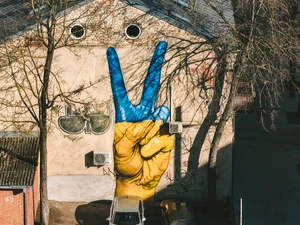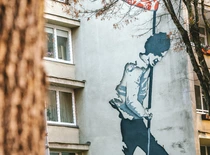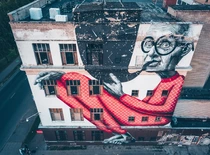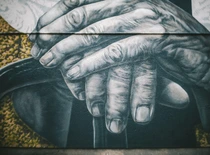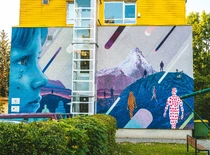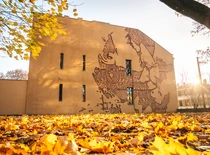Kaunas University of Technology (KTU) linguists have analysed murals in Lithuania’s second-largest city as elements of a “linguistic landscape” – a concept that views language as both visual and spatial. Their study reveals that street art in Kaunas acts as a form of cultural activism and collective memory, blending languages, images, and historical narratives.
The researchers, Professors Saulutė Juzelėnienė and Saulė Petronienė, argue that multilingual murals created during Kaunas’ year as the European Capital of Culture do more than beautify walls – they reshape how residents see their city, its history, and themselves. While some works were commissioned as part of official programmes, the scholars note that they have become powerful tools for community reflection and dialogue, turning public space into a living archive of cultural identity.
“Kaunas is a city with a strong sense of identity, being one of the most Lithuanian of our major cities. However, it is important to remember that Jews, Poles, Russians, Germans and people of other nationalities also lived here between the wars. In fact, Kaunas’ bohemian community consisted of scholars who had studied at European universities,” says Professor Petronienė, head of the KTU Centre of Foreign Languages.
According to the scholars, the linguistic landscape encompasses all visible forms of language in public spaces, including signs, inscriptions, advertisements, graffiti and murals. Language consists not only of words, but also of visual symbols, colours and local context.
Having chosen the murals decorating the buildings in the centre of Kaunas as the subject of their research, the academics argue that commemorating multiculturalism – a historically defining feature of Kaunas – through art is crucial.
“Murals are one of the most effective and accessible ways of introducing visitors and residents to the city’s history, and of ensuring that it is not forgotten,” says Prof. Petronienė.
Street art as a form of cultural activism
Research conducted by KTU scientists has revealed not only the multilingual nature of Kaunas’ murals. It has also shown that these works of art are a form of cultural activism, inspiring pride in the city and encouraging a deeper interest in its history.
“Street art works quietly and subtly through its everyday presence. This sparks people’s interest, prompting them to ask questions, take photos and share stories. Murals become embedded in the collective memory. This transforms the relationship between the city’s residents and their surroundings,” says Prof. Juzelėnienė.
She admits that she became interested in street art several years ago, when her family bought an apartment in an apartment block near the synagogue. This building is now well known to Kaunas residents and visitors as the Kiemas Gallery (Eng. Courtyard Gallery).
“At that time, only a few initial drawings commemorating the Jews who had lived there before and suffered in the Holocaust graced the courtyard walls. Drawing on my experience of coordinating and participating in international projects, I wanted to contribute to expanding this further,” recalls Prof. Juzelėnienė.
Once the projects received funding, new drawings appeared on the walls, and the courtyard gradually turned into a gallery – a cultural space where art became a form of communication. “I feel like I have contributed to the development of this place,” says Juzelėnienė with a smile.
A way to revitalise a city
“During the conception, creation and implementation of mural projects, communities come together and often remain more focused and socially active after the project has ended,” says Petronienė.
For example, the professor refers to the history of Herlen, a city in the Netherlands that was depopulated and abandoned following the decline of the coal industry. She argues that the city’s history is evident in its many high-rise buildings. However, before the introduction of street art, the abandoned areas did indeed appear uninviting. “Today, it is an attractive and lively city, whose revival was prompted by wall paintings,” says the head of the KTU Centre of Foreign Languages.
As an exceptional example of wall painting, Petronienė mentions Belfast, the capital of Northern Ireland, whose murals tell the story of the Troubles, one of the bloodiest and longest conflicts in Irish history. According to her, in this case, the walls really do speak: “It’s not just art, but also a channel of communication in the wide sense of the word, because the drawings often feature text.”
The dialogue continues even if the murals fade
In addition to analysing the murals, the KTU scientists interviewed the artists who created them. They said that the communicative aspect of street art is very important.
All the murals analysed by KTU researchers were created around the time that Kaunas was preparing to become the European Capital of Culture. To what extent did this fact influence the content of the analysed works? After all, they may convey an official, institutional narrative rather than the authentic voice of the community.
According to Juzelėnienė, if we analysed other/different wall paintings located outside the centre of Kaunas, we would probably hear more voices of protest and criticism. “Both official and alternative voices would be included in the city’s linguistic landscape. Such a study would probably present a slightly different cultural portrait of Kaunas,” says a KTU professor.
However, KTU researchers disagree with the suggestion that the value of murals is diminished by so-called “institutional regulation”. On the contrary, they have created an opportunity to tell stories that have been silenced for many years.
“Our younger generation may be unfamiliar with Kaunas’s rich, meaningful and multilingual history. These works of wall art convey a message that can encourage them to develop a deeper interest and talk to more knowledgeable family members, friends or teachers,” says Petronienė.
The above-described study was published in the “Journal of Multilingual and Multicultural Development” and can be accessed through this link.





